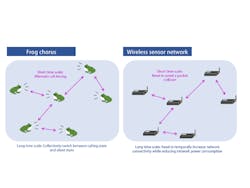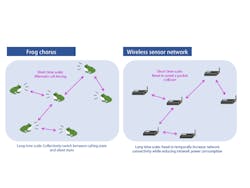As wireless sensors continue to proliferate in process automation with the growth of the Industrial Internet of Things (IIoT), ensuring their networks accurately communicate the various messages is essential. Noting the unique communications of frogs, researchers at Osaka University and University of Tsukuba in Japan conducted research to leverage the natural communication method to improve wireless network communications.
Recently published in the journal Royal Society Open Science with the title “Mathematical modelling and application of frog choruses as an autonomous distributed communication system,” the research looked at the calling patterns of three male Japanese tree frogs. The team placed the frogs inside individual cages to record their communications during various time intervals. From this, they found that frogs avoid overlapping one another with their calls and alternate between croaking and silence. Using this data, the team developed a mathematical model that adapted this information for wireless network communications.
“We found neighboring frogs avoided temporal overlap, which allows a clear path for individual voices to be heard. In this same way, neighboring nodes in a sensor network need to alternate the timings of data transmission so the data packets don’t collide,” study co-author Daichi Kominami explained in a statement.
The researchers also noticed times of collective silence and choruses, which featured deterministic overlap avoidance with collective calls being more stochastic. Additionally, the pattern of silence allows the frogs to rest and conserve energy. Taking their research further, the researchers created another model that adopted the frogs’ interaction patterns to a phase-based format.
Relationship between a frog chorus and a wireless sensor network. (Source: Osaka University)
Lead author Ikkyu Aihara explained in a statement: “We modeled the calling and silent states in a deterministic way, while modeled transitions to and from them in a stochastic way. These models qualitatively reproduced the calling pattern of actual frogs and were then helpful in designing autonomous distributed communication systems.”
Finally, the team utilized the model for data traffic management in a wireless sensor network and found that the short-time-scale alteration was effective in avoiding data packet collisions, and cyclic and collective transitions in long-time scale helped regulate energy consumption, the article reports.
Creating better communications within wireless sensor networks is important for many industries, but who could have guessed that it would be frogs that would show us the way?
About the Author
Amanda Del Buono
Amanda Del Buono

Leaders relevant to this article:

